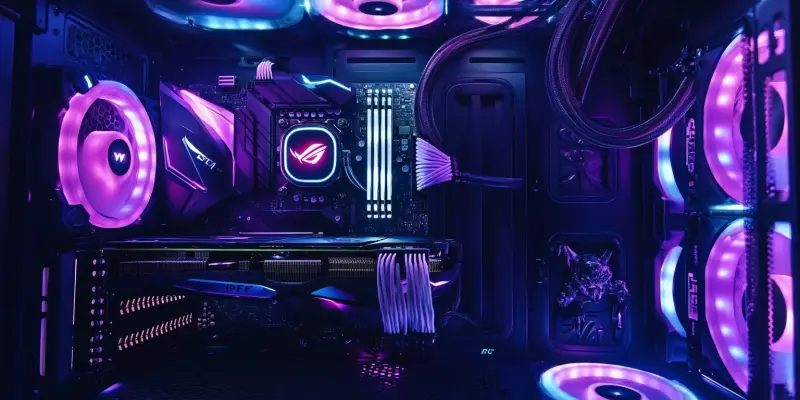In an industry where innovation is constant and the quest for better performance is unceasing, the recently unveiled BTF 3.0 PC standard offers a promising glimpse into the future of PC assembly, aiming to eliminate the cumbersome cables that have long been a staple of computer construction. Developed by Asus in collaboration with other prominent tech companies, BTF 3.0 endeavors to streamline the assembly process by relocating all non-chassis-related wiring to the back of the motherboard, enhancing cable management and potentially making the entire system safer and more efficient.
The BTF 3.0 Design Revolution
Eliminating Cable Clutter
One of the principal objectives of BTF 3.0 is to drastically reduce the number of visible cables within a PC build, a feature that will likely appeal to both novice and experienced builders alike. This is achieved through the introduction of a 50-pin connector located on the rear of a 12VO motherboard. This innovative design replaces the traditional EPS dual 8-pin, 24-pin motherboard, and 12V-2×6 GPU connectors. Consequently, the only front-facing cables that remain are those required for essential components such as coolers, SATA devices, fans, and RGB lights. By rerouting the majority of cabling to the back of the motherboard, BTF 3.0 significantly enhances the aesthetics of the build while simplifying the construction process.
The relocation of cabling also has practical benefits beyond mere appearance. With fewer cables in the way, airflow within the case can improve, potentially leading to better cooling performance. Moreover, this layout reduces the chances of poor connections or the kind of electrical issues that plagued early power connectors for the RTX 4090, adding an extra layer of reliability to the system. For those new to PC building, the cleaner and more organized arrangement facilitated by BTF 3.0 could lower the barrier to entry, reducing the potential for mistakes that could compromise a build’s stability or safety.
Increased Power Delivery
Another significant advantage of the BTF 3.0 standard is its capacity to deliver considerably more power to system components, with a power budget that can extend up to 1,500 watts. This is particularly beneficial as modern PCs continue to advance and become more power-hungry, with components such as high-end GPUs and multiple storage devices demanding a stable and ample power supply. By integrating a high-capacity power delivery system directly into the motherboard’s design, BTF 3.0 ensures that all connected components receive sufficient power without the need for additional cables and connectors.
The potential for increased power delivery also points to future readiness. As we anticipate new generations of CPUs, GPUs, and other components that will likely require more power, having a power supply standard that can accommodate these needs right out of the box is invaluable. It means builders won’t need to upgrade their PSUs as frequently, reducing both cost and hassle. This future-proofing aspect of BTF 3.0 could be a compelling reason for both enthusiasts and professionals to adopt the new standard, ensuring their setups remain capable of handling the latest hardware advancements.
Challenges and Adoption
Compatibility Issues
Despite the evident advantages, the widespread adoption of BTF 3.0 hinges on overcoming significant challenges, primarily the need for new compatible hardware. The transition to this new standard requires not only a new motherboard but also GPUs and PSUs that are specifically designed to support BTF 3.0. This may present a barrier to entry for many users, as it would necessitate replacing multiple core components, a costly and potentially prohibitive undertaking for some. Additionally, the success of this new standard depends on industry-wide acceptance, requiring major PC component manufacturers to adopt and approve a common set of connectors.
To spur industry-wide acceptance, Asus and its collaborators must effectively communicate the benefits of BTF 3.0 to both consumers and other manufacturers. Demonstrations at major tech events and comprehensive reviews that highlight the enhanced ease of assembly, improved safety, and overall better performance could play a pivotal role in driving adoption. Without a unified effort and clear value proposition, however, there is a risk that BTF 3.0 could remain a niche solution rather than achieving mainstream success.
Prospects at CES and Beyond
In an ever-evolving industry where technology is constantly advancing, the introduction of the BTF 3.0 PC standard marks a significant innovation, aiming to transform the landscape of PC assembly. This new standard, recently introduced by Asus in collaboration with several key tech companies, promises to eliminate the need for cumbersome cables that have long been a staple of traditional computer setups. The BTF 3.0 standard aspires to streamline the assembly process by relocating all non-chassis-related wiring to the back of the motherboard. This design not only enhances cable management but also potentially increases the system’s safety and efficiency. By shifting the wiring to a less obtrusive location, the BTF 3.0 makes the construction process cleaner and more organized, paving the way for a new era in PC building that prioritizes both aesthetics and functionality. This breakthrough addresses long-standing issues with cable clutter and airflow, offering a cleaner interior look and better thermal management, essential for high-performance computing environments.

